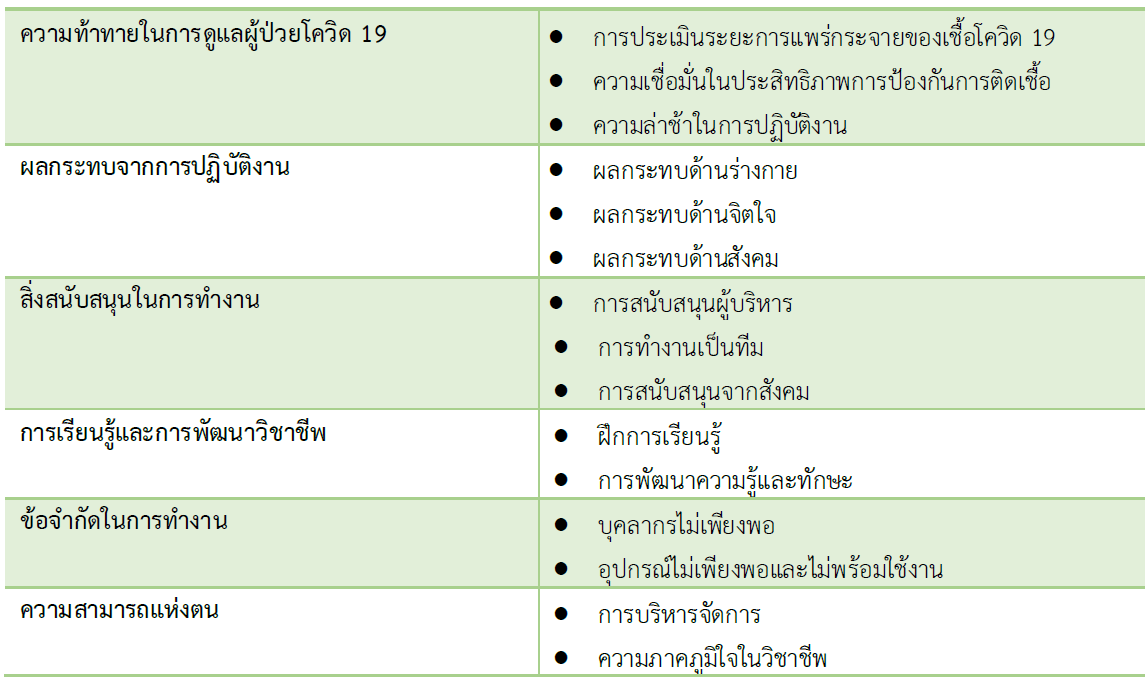ประสบการณ์ของพยาบาลวิชาชีพในการดูแลผู้ป่วยโรคโควิด 19 ที่โรงพยาบาลระดับทุติยภูมิ จังหวัดนนทบุรี: วิจัยเชิงปรากฏการณ์วิทยา
คำสำคัญ:
ประสบการณ์, พยาบาลวิชาชีพ, การดูแล, ผู้ป่วยโรคโควิด 19, โรงพยาบาลระดับทุติยภูมิบทคัดย่อ
การวิจัยเชิงปรากฏการณ์วิทยานี้ มีวัตถุประสงค์เพื่อศึกษาความหมายของการดูแลผู้ป่วยโรคโควิด 19 และศึกษาการรับรู้จากประสบการณ์ในการดูแลผู้ป่วยโรคโควิด 19 กลุ่มตัวอย่าง คือ พยาบาลวิชาชีพที่ปฏิบัติงานในการดูแลผู้ป่วยโรคโควิด 19 ที่โรงพยาบาลระดับทุติยภูมิแห่งหนึ่งในจังหวัดนนทบุรี เลือกผู้ให้ข้อมูลแบบเจาะจง ข้อมูลอิ่มตัวจากผู้ให้ข้อมูล จำนวน 15 คน เครื่องมือประกอบด้วยแบบการสัมภาษณ์กึ่งโครงสร้าง วิเคราะห์ข้อมูลเชิงเนื้อหาตามแนวทางของจอร์จี ผลการวิจัย พบว่า
1. การดูแลผู้ป่วยโรคโควิด 19 หมายถึง “การพยาบาลผู้ป่วยที่ติดเชื้อไวรัสอุบัติใหม่ที่แพร่กระจายทางระบบทางเดินหายใจอาจถึงขั้นเสียชีวิต พยาบาลต้องมีการเตรียมความพร้อมทั้งด้านความรู้ ด้านร่างกาย และจิตใจก่อนให้การพยาบาลเพื่อประสิทธิภาพและความปลอดภัยของการดูแลผู้ป่วย”
2. การรับรู้จากประสบการณ์ตรงในการดูแลผู้ป่วยโรคโควิด 19 ของพยาบาลที่ปฏิบัติงานในโรงพยาบาลระดับทุติยภูมิ จังหวัดนนทบุรี สรุปได้ประเด็นหลัก 6 ประเด็น ได้แก่ ความท้าทายในดูแลผู้ป่วยโรคโควิด 19 ผลกระทบจากการปฏิบัติงาน สิ่งสนับสนุนในการทำงาน การเรียนรู้และการพัฒนาวิชาชีพ ข้อจำกัดในการทำงาน และความสามารถแห่งตน และประเด็นย่อย 15 ประเด็น
ผลการวิจัยครั้งนี้สามารถนำไปเป็นแนวทางในการเตรียมความพร้อมในการรับมือโรคอุบัติใหม่ เพื่อให้มีการเตรียมการอย่างทันท่วงที เพิ่มประสิทธิภาพและลดความเสี่ยงจากการปฏิบัติงาน
เอกสารอ้างอิง
Abraham, C., & Sheeran, P. (2015). The Health Belief Model. Retrieved December 15, 2021 from https://www.researchgate.net/publication/290193215_The_Health_Belief_Model
Alinejad, N., Bijani, M., Malekhosseini, M., Nasrabadi, M., Harsini, P. A., & Jeihooni, A. K. (2023). Effect of educational intervention based on health belief model on nurses’ compliance with standard precautions in preventing needle stick injuries. BMC Nursing, 22(1), 1–10. doi.org/10.1186/s12912-023-01347-0
Bangbuathong hospital. (2564). Indicators Report of Bangbuathong Hospital in Quarter 1-2 on 30 March 2021. (in Thai)
Broujeni, R. B., Kamalzadeh, H., Ahmadi, Z., & Abedini, S. (2023). Through the eyes of nurses: a content analysis of nurses’ experiences in caring for COVID-19 patients. BMC Nursing, 22,1–9. doi.org/10.1186/s12912-023-01601-5
Catania, G., Zanini, M., Hayter, M., Timmins, F., Dasso, N., Ottonello, G., et al. (2021). Lessons from Italian front‐line nurses’ experiences during the COVID‐19 pandemic: A qualitative descriptive study. Journal of Nursing Management, 29(3), 404–411. doi.org/10.1111/jonm.13194
Campos Santos, T. C., da Costa Soares, G., Oliveira de Lima, K. C., Cardoso de Souza, B. B., Câncio Velloso, I. S., & da Silva Caram, C. (2024). Nurses’ workload during the COVID-19 pandemic: potential for experiences of moral distress. Revista Brasileira de Enfermagem, 77, 1–7. doi.org/10.1590/0034-7167-2023-0200
Chaudhry, F. B., & Raza, S. (2020). COVID 19: Frontline experience at a tertiary care hospital in UK. Journal of Global Health, 10(1), 1–5. doi.org/10.7189/jogh.10.010356
Denzin, N. K., Lincoln, Y. S., MacLure, M., Otterstad, A. M., Torrance, H., Cannella, G. S., et al. (2018). Critical qualitative methodologies reconceptualizations and emergent construction. International Review of Qualitative Research. doi.org/10.1525/irqr.2017.10.4.482
Galehdar, N., Toulabi, T., Kamran, A., & Heydari, H. (2020). Exploring nurses’ perception about the care needs of patients with COVID-19: a qualitative study. BMC Nursing, 19(1), 1–8. doi.org/10.1186/s12912-020-00516-9
Giorgi, A. (1985). Phenomenology and Psychological Research. Pittsburgh, Pennsylvania: Duquesne University Press.
Gursoy, E., Saglam, H. Y., & Yavuz, N. S. (2023). Experiences of intensive care nurses working with patients with COVID-19: A qualitative study in Turkey. Nursing Practice Today, 10(2), 124-137. doi.org/10.18502/npt.v10i2.12833
Lee, J. E. (2022). A study on Job Stress, Burnout, and Turnover Intention in Infection Control Nurses During an Outbreak of COVID-19 [Master's thesis]. Seoul: Korea University.
Liu, Q., Luo, D., Haase, J. E., Guo, Q., Wang, X. Q., Liu, S., Xia, L., Liu, Z., Yang, J., & Yang, B. X. (2020). The experiences of health-care providers during the COVID-19 crisis in China: a qualitative study. The Lancet. Global Health, 8(6), e790–e798. doi.org/10.1016/S2214-109X(20)30204-7.
LoGiudice, J. A., & Bartos, S. (2021). Experiences of nurses during the COVID-19 pandemic: A mixed-methods study. AACN Advanced Critical Care, 32(1), 14–26. doi.org/10.4037/aacnacc2021816
Mizumoto, J. (2023). Judgment of data saturation. The British Journal of General Practice: The Journal of the Royal College of General Practitioners, 73(736), 491. doi.org/10.3399/bjgp23X735321
Nawagi, F., Lubega, M., Ajambo, A., Mukisa, J., & Nabirye, R. (2023). “We felt so proud by the president calling us my heroes.” An exploration of the nurse’s experiences in the management of COVID-19 patients in Uganda. BMC Nursing, 22(1), 1–9. doi.org/10.1186/s12912-023-01503-6
Nittayasoot, N., Suphanchaimat, R., Namwat, C., Dejburum, P., & Tangcharoensathien, V. (2021). Public health policies and health-care workers’ response to the COVID-19 pandemic, Thailand. Bulletin of the World Health Organization, 99(4), 312–318. doi.org/10.2471/BLT.20.275818
Saffari M, Sanaeinasab H, Rashidi-Jahan H, Aghazadeh F, Raei M, Rahmati F, Al Zaben F, & Koenig HG. (2024). An intervention program using the health belief model to modify lifestyle in coronary heart disease: Randomized controlled trial. International Journal of Behavioral Medicine, 31(4), 631–641. doi.org/10.1007/s12529-023-10201-1
Schwartz, J., King, C. C., & Yen, M. Y. (2020). Protecting healthcare workers during the coronavirus disease 2019 (COVID-19) outbreak: lessons from Taiwan’s severe acute respiratory syndrome response. Clinical Infectious Diseases, 71(15), 858-860.
Thanirat, S., Radabutr, M., Wichianrat, S., & Opasawatchai, S. (2020). Strategies to relieve a social stigma on COVID-19. Kuakarun Journal of Nursing,.27(2), 164-174. (in Thai)
Lee, S. J., Kim, S. H., & Park, J. Y. (2024). Infection control nurses’ burnout experiences in hospitals during the COVID-19 pandemic. Journal of Korean Academy of Fundamentals of Nursing, 31(1), 135–146. doi.org/10.7739/jkafn.2024.31.1.135
Tekalign, T., Awoke, N., Eshetu, K., Gelaw Walle, B., & Teshome Guta, M. (2022). HIV/AIDS post‐exposure prophylaxis knowledge and uptake among health professionals in Africa: Systematic review and meta‐analysis. HIV Medicine, 23(8), 811-824.
Zewdie A, Nigusie A, & Wolde M. (2024). Structural equation modeling analysis of health belief model-based determinants of COVID-19 preventive behavior of academic staff: a cross-sectional study. BMC Infectious Diseases, 24(1), 788. doi.org/10.1186/s12879-024-09697-z

ดาวน์โหลด
เผยแพร่แล้ว
ฉบับ
ประเภทบทความ
สัญญาอนุญาต
ลิขสิทธิ์ (c) 2024 วารสารเครือข่ายวิทยาลัยพยาบาลและการสาธารณสุขภาคใต้

อนุญาตภายใต้เงื่อนไข Creative Commons Attribution-NonCommercial-NoDerivatives 4.0 International License.
1. บทความหรือข้อคิดเห็นใด ๆ ที่ปรากฏในวารสารเครือข่าย วิทยาลัยพยาบาลและการสาธารณสุขภาคใต้ ที่เป็นวรรณกรรมของผู้เขียน บรรณาธิการหรือเครือข่ายวิทยาลัยพยาบาลและวิทยาลัยการสาธารณสุขภาคใต้ ไม่จำเป็นต้องเห็นด้วย
2. บทความที่ได้รับการตีพิมพ์ถือเป็นลิขสิทธิ์ของ วารสารเครือข่ายวิทยาลัยพยาบาลและการสาธารณสุขภาคใต้







